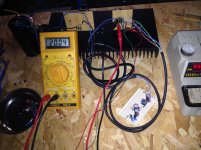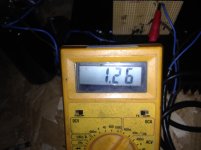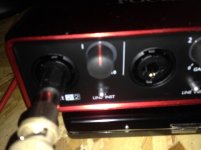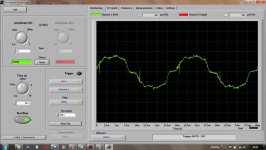Let's not forget, there is also the contrarian point of view: as far as the sound is concerned all regulators suck, the shunts just suck a bit less.
In a complex dac there is little choice but to use regulators, often in very large numbers. In analogue circuitry the need is less obvious and so is the outcome.
Usually i like what good regulators do, but there have been exceptions.
In a complex dac there is little choice but to use regulators, often in very large numbers. In analogue circuitry the need is less obvious and so is the outcome.
Usually i like what good regulators do, but there have been exceptions.
Assuming that there is sufficient headroom on the input of the second regulator, and the instantaneous current demand can be supplied, then yes; otherwise it will be compromised.
Thanks for reply! Given my limited knowledge of electronics, I think the instantaneous current demand and supply is what the designers mean with the output impedance wrt frequency. That's why I thought that the pre regulator should be at least as good as the post regulator, but I can't tell... Does it matter what is the output impedance at any other frequencies than 100/120Hz anyway?
I'm just a hobbyist too, knowledge is also limited.
You almost answered your own question.
For shunt regulators, the pre reg has to supply a constant current, it's a static condition; with series regs, the load current is dynamic, and is passed on to the pre reg, this is a much more demanding condition for the pre reg's control circuit to cope with, the pre reg now needs a bandwidth, it didn't with the shunt. The limitation is not the component, but how you use it.
You almost answered your own question.
For shunt regulators, the pre reg has to supply a constant current, it's a static condition; with series regs, the load current is dynamic, and is passed on to the pre reg, this is a much more demanding condition for the pre reg's control circuit to cope with, the pre reg now needs a bandwidth, it didn't with the shunt. The limitation is not the component, but how you use it.
For shunt regulators, the pre reg has to supply a constant current
Uhm, no. A preregulator supplies constant voltage, the constant current source is a part of the shunt regulator.
I'm just a hobbyist too, knowledge is also limited.
You almost answered your own question.
For shunt regulators, the pre reg has to supply a constant current, it's a static condition; with series regs, the load current is dynamic, and is passed on to the pre reg, this is a much more demanding condition for the pre reg's control circuit to cope with, the pre reg now needs a bandwidth, it didn't with the shunt. The limitation is not the component, but how you use it.
OK! That makes it very clear to me now. Thank you very much for the explanation!
Correct, pre reg job 1, and where does the current come from? pre reg job 2
Just pointed out it is wrong to call an integral part of a regulator with a confusing and misleading name. The ccs is just that, it is not a "pre" anything.
I think the misunderstanding is - the pre reg (before the ccs) is providing a constant current (the circuit demand), not 'is' a constant current.
Is this your view/experience......can you elaborate please ?.Let's not forget, there is also the contrarian point of view: as far as the sound is concerned all regulators suck, the shunts just suck a bit less.
Sure, +5v and +3.3v need to be precise, what is this outcome for analogue ?.In a complex dac there is little choice but to use regulators, often in very large numbers. In analogue circuitry the need is less obvious and so is the outcome.
What is good vs bad regulation subjectively, and what are the schematic differences ?.Usually i like what good regulators do, but there have been exceptions.
Dan.
Let's not forget, there is also the contrarian point of view: as far as the sound is concerned all regulators suck, the shunts just suck a bit less.
Back that up with some statistics.
A shunt regulator with a poorly designed error amplifier will suck gas mightily.
No one has pointed it out yet, the TL431 is missing a 1K resistor from the top of the pre-set to +S 😱
Time for an update, parts arrived, kludged something together, no exotic parts used; apart from the RS brand on the main reservoir cap, the 220uF & 0.1uF are the cheap and unbranded kind.
Pictures are better than words.
Forgot to fully edit the schematic, diodes are now a 35A bridge, input cap is 33,000uF.
Time for an update, parts arrived, kludged something together, no exotic parts used; apart from the RS brand on the main reservoir cap, the 220uF & 0.1uF are the cheap and unbranded kind.
Pictures are better than words.
Forgot to fully edit the schematic, diodes are now a 35A bridge, input cap is 33,000uF.
Attachments
Last edited:
To be honest, it looks too good to be true, the 2i2 is set to a gain of 5(ish); maybe I should make another interface cable, it's 100K 1uF 10K // 2x anti // 1N4002; that's no attenuation (-3dB @ 16Hz) and about 10K in // with the 2i2 input.
I assume the 2i2 is AC coupled (Phantom power button) but I didn't fancy feeding 20V DC into it without knowing for definite, can anyone confirm either way?
I assume the 2i2 is AC coupled (Phantom power button) but I didn't fancy feeding 20V DC into it without knowing for definite, can anyone confirm either way?
What is good vs bad regulation subjectively, and what are the schematic differences ?.
Dan, slightly surprised that you are asking, but in short here is my experience.
Regulators generally improve perception of leading edges but have issues with decays. Generally improve bass and rhythm but make the highs sound electronic and processed.
Given up on series regulators for any kind of critical analogue application. Digital also seems to benefit from shunts, but perhaps to a lower degree.
What works where...sorry, don't have an answer. Some combinations just refuse to sound good for no obvious reason. Here is a simple example.
My valve system is balanced. Balanced differential preamp with a transformer coupled output. Valve rectification for B+ and B-, multiple choke filtration of the raw dc, Salas shunt. The power amp uses exactly the same input stage as the preamp: differential input stage transformer coupled to the output valves, similar raw dc supply. And here is the strange bit: unlike the preamp, the power amp input stage sounds much better without being regulated. The Salas regulator applied there kills all dynamics and life. Ok, so it is not entirely the same as the preamp, as the voltage levels are 50-60 times higher but the current consumption is the same...
This long story illustrates the simple fact that there can be no universal recipes.
In power amps to split the driver's power source from the output's can end up weird when their two power sources are not of close characteristics. One's stiff the other sags. Its not the most practical thing to also have a regulated power source for the output stage of course. Especially if shunt. Nonetheless sag is perceptually more dynamic than stiff when the power amp is moderate for some load and has to compress from time to time. Have had such experiences in small power valve amps (up to 20W) when trying stages rail splits with a MOS Maida first which is series and chip based so its easier to apply for a check. Results almost as you described, although blacker and more detailed, when with just an RC cell coming down from the output's raw B+ it feels more timed and dynamically closer to normal. Still bit rough around the edges but hanging better together.
One of the biggest audible upgrades in this particular power amp was a separate PS for the drivers. So, in any case the sag caused from the outputs is not transmitted to the drivers.
You may very well be right that even the small sag caused by the driver stage alone is responsible for more subjective dynamics.
You may very well be right that even the small sag caused by the driver stage alone is responsible for more subjective dynamics.
- Status
- Not open for further replies.
- Home
- Amplifiers
- Power Supplies
- Shunt reg shoot out




